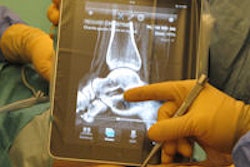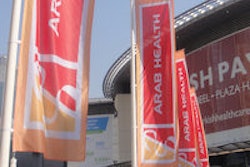
DUBAI - Tablets and mobile devices offer huge potential for viewing images, particularly in the emergency room and in consultations with referring physicians, but they will not replace diagnostic workstations, predicted two expert speakers on day three of Arab Health.
"There is still a lot to do for clinical validation," said Dr. Lorenzo Faggioni, PhD, a staff radiologist at the University Hospital of Pisa, Italy. "But this technology exists and is already being widely used."
 There's still a lot to do before tablets can be used in clinical practice, according to Dr. Lorenzo Faggioni, PhD, from Pisa, Italy.
There's still a lot to do before tablets can be used in clinical practice, according to Dr. Lorenzo Faggioni, PhD, from Pisa, Italy.
Tablets have become a useful adjunct and integration tool, but they are not as powerful and ergonomic as regular workstations, and they cannot cope with postprocessing of images, mammography, and other tasks, he explained.
In the reporting of CT colonography (CTC) and musculoskeletal MRI examinations, for instance, an Apple iPad can perform equally as well as an iMac. In his group's study of CTC exams, all lesions detected on the iMac were also identified on the iPad, and their segmental localization was correctly assessed in all cases. Image quality was good with both devices, but image reading time was longer on the iPad than on the iMac (5.32 ± 2.16 versus 3.51 ± 1.58 minutes, respectively).
Despite the appeal of tablets, they require a thoughtful approach, and it is important not to implement technology for technology's sake, warned Dr. Erik Ranschaert, PhD, a radiologist at Jeroen Bosch Hospital in Den Bosch, the Netherlands. To get the full benefits of these devices, he urges radiologists to analyze them and understand them.
In terms of viewing angles, brightness, and contrast levels, tablets can match up to diagnostic monitors. Also, the cost of an iPad2 is $400 to $530 U.S. (295 to 391 euros) against about 10 times more than 2- to 3-megapixel (MP) diagnostic LCD screen. But iPads cannot compete with the screen size and resolution of modern medical displays, he said.
 iPads have high-quality displays, but they don't have DICOM calibration, said Dr. Erik Ranschaert, PhD, from Den Bosch, the Netherlands.
iPads have high-quality displays, but they don't have DICOM calibration, said Dr. Erik Ranschaert, PhD, from Den Bosch, the Netherlands.
"It is a necessity to have a calibration tool on display on a diagnostic workstation to make a confident diagnosis. iPads have high-quality displays, but they don't have DICOM calibration, so there is no quality assurance during the display's life because it is not being monitored, and there's no contrast control," Ranschaert commented. "There are solutions, but they are not using the calibration software as we know it in the diagnostic workstation."
According to guidelines from the U.S. Food and Drug Administration, a display must be 20 to 24 inches (51 to 61 cm) diagonal for diagnostic purposes, unless a larger panel is being used to serve as a pair of monitors. The screen size of an iPad is 9.7 inches (25 cm), whereas an iPhone is 3.5 inches (9 cm). For clinical review, anything goes, however.
The top five apps for radiology are Mobile MIM, Resolution MD mobile, eFilm mobile HD, Osirix HD, and iClarity, Ranschaert noted. HTML5 DICOM viewers are worth consideration because they can be used without installing additional software, they use the "zero footprint principle" (no installation, no data storage at client), and they have security advantages and facilitate cross-platform usage.
The growing popularity of tablets is undeniable, he pointed out. In a 2012 survey of more than 3,000 U.S. physicians, 62% of respondents own a tablet, and 50% use it in their practice. The ideal users are medical specialists, including radiologists, because they work in spaces covered by Wi-Fi, they have heavy information needs, and they tend to be mobile within a hospital, he said.
Other safety issues to deal with are the fact that tablets are easily stolen or lost and therefore should not contain patient data, according to Ranschaert. This problem can be solved by using HTML5 viewers or by installing ICT management tools that give greater control over those medical data.



















